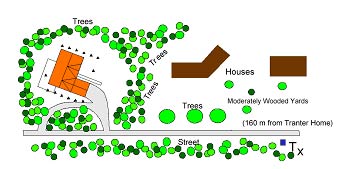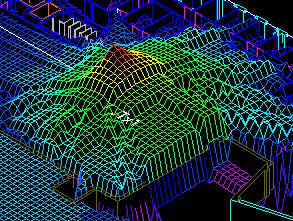

PSE Research Projects
S4W (Site-Specific System Simulator for Wireless Communications) is a collaborative PSE for the design and analysis of wideband wireless communications systems. In contrast to the above described projects, the S4W project is occurring in parallel with the development of high-fidelity propagation and channel models; this poses a unique set of requirements for software system design and implementation. S4W has the ability to import a 3-dimensional database representing a specific site (see Figure), and permits a wide range of radio propagation models to be used for practical communications. For example, in a commercial wireless deployment, there is a need to budget resources, such as radio channel assignments and the number of transmitters. S4W allows wireless engineers to automatically drive the simulation models to maximize coverage or capacity, or to minimize cost. Furthermore, unlike existing tools, S4W permits the user to import measured radio data from the field, and to use this data to improve the models used in the simulation. A knowledge-based recommender system provides improved modeling capability as the software corrects the environment model and the parameters in the propagation model, based on measured data. Finally, the ability to optimize the location of particular wireless portals in an arbitrary environment is a fundamental breakthrough for wireless deployment, and S4W has the ability to perform optimization based on a criterion of coverage, QoS, or cost (see Figure).
While primitive software tools exist for cellular and PCS system design, none of these tools include models adequate to simulate broadband wireless systems, nor do they model the multipath effects due to buildings and other man-made objects. Furthermore, currently available tools do not adequately allow the inclusion of new models into the system, visualization of results produced by the models, integration of optimization loops around the models, validation of models by comparison with field measurements, and management of the results produced by a large series of experiments. One of the major contributions of S4W is a lightweight data management subsystem that supports the experiment definition, data acquisition, data analysis, and inference processes in wireless system design. In particular, this facility helps manage the execution environment, binds representations to appropriate implementations in a scientific computing language, and aids in reasoning about models and model instances.
Supported by a $1M grant from the NSF Next Generation Software program, S4W is designed to enhance three different kinds of performance-software, product, and designer. Superior software performance is addressed in this project by (i) developing fundamentally better wireless communication models, (ii) constructing better simulation systems composed from the component wireless models via the recommender, and (iii) the transparent use of parallel high-performance computing hardware via the composition environment's access to distributed resources. Superior product performance (the actual deployed wireless systems) is addressed by using optimization to design optimal rather than merely feasible systems. Superior designer performance is directly addressed by the synergy resulting from the integrated PSE, whose purpose is to improve designer performance and productivity
Last modified: November 5, 2001

